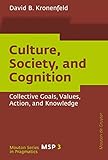Culture, Society, and Cognition : Collective Goals, Values, Action, and Knowledge / David B. Kronenfeld.
Material type: TextSeries: Mouton Series in Pragmatics [MSP] ; 3Publisher: Berlin ; Boston : De Gruyter Mouton, [2008]Copyright date: ©2008Description: 1 online resource (277 p.)Content type:
TextSeries: Mouton Series in Pragmatics [MSP] ; 3Publisher: Berlin ; Boston : De Gruyter Mouton, [2008]Copyright date: ©2008Description: 1 online resource (277 p.)Content type: - 9783110206074
- 9783110211481
- 306.4201 22/ger
- HM621 .K76 2008
- online - DeGruyter
- Issued also in print.
| Item type | Current library | Call number | URL | Status | Notes | Barcode | |
|---|---|---|---|---|---|---|---|
 eBook
eBook
|
Biblioteca "Angelicum" Pont. Univ. S.Tommaso d'Aquino Nuvola online | online - DeGruyter (Browse shelf(Opens below)) | Online access | Not for loan (Accesso limitato) | Accesso per gli utenti autorizzati / Access for authorized users | (dgr)9783110211481 |
Browsing Biblioteca "Angelicum" Pont. Univ. S.Tommaso d'Aquino shelves, Shelving location: Nuvola online Close shelf browser (Hides shelf browser)

|

|

|

|

|

|

|
||
| online - DeGruyter Quotative Indexes in African Languages : A Synchronic and Diachronic Survey / | online - DeGruyter On Pied-Piping : Wh-Movement and Beyond / | online - DeGruyter Intention, Common Ground and the Egocentric Speaker-Hearer / | online - DeGruyter Culture, Society, and Cognition : Collective Goals, Values, Action, and Knowledge / | online - DeGruyter Coordination Relations in the Languages of Europe and Beyond / | online - DeGruyter Annual Review of South Asian Languages and Linguistics : 2008 / | online - DeGruyter Meaning in the Second Language / |
Frontmatter -- Contents -- Chapter 1. Introduction -- Chapter 2. Background and history -- Chapter 3. Language to culture – building from Kronenfeld’s semantic theory -- Chapter 4. Culture as distributed cognition -- Chapter 5. An agent-based approach to cultural (and linguistic) change: Examples -- Chapter 6. Society (with a note on the self) -- Chapter 7. Ethnicity -- Chapter 8. The social construction of ethnicity: Intuition, authenticity, authenticators – the Sami example -- Chapter 9. Some kinds of cultural knowledge – a non-exhaustive list -- Chapter 10. Illustrative Examples -- Chapter 11. Problems – messages vs. codes -- Chapter 12. Other theoretical issues and relationships -- Chapter 13. Illustrative examples: cultural models -- Chapter 14. Gregory Bateson: pulling it all together -- Backmatter
restricted access online access with authorization star
http://purl.org/coar/access_right/c_16ec
This theoretically motivated approach to pragmatics (vs. semantics) produces a radically new view of culture and its role vis-a-vis society. Understanding what words mean in use requires an open-ended recourse to pragmatic cultural knowledge. Cultural knowledge makes up a productive conceptual system. Members of a cultural community share the system but not all of the system's content, making culture a system of parallel distributed cognition. This book presents such a system, and then elaborates a version of "cultural models" that relates actions to goals, values, emotional content, and context, and that allows both systematic generative capacity and systematic variation across cultural and subcultural groups. Such models are offered as the basic units of cultural action. Culture thus conceived is shown as a tool that people use rather than as something deeply internalized in their psyches.
Issued also in print.
Mode of access: Internet via World Wide Web.
In English.
Description based on online resource; title from PDF title page (publisher's Web site, viewed 28. Feb 2023)


